In drilling, experience has always been the best teacher, and improved efficiency and safety have topped the drilling report card.
Marco Aburto and Robert Clyde, Schlumberger
Anyone who has drilled through salt sections knows that it can be boring—no pun intended. Logs obtained while drilling salt draw straight lines, so geosteering is out of the question. About the only incentive is to get through the salt as quickly as possible and without incident to tap promising strata lying beneath. Operators focused on the bottom line may say, “Pick up the cheapest BottomHole Assembly (BHA) you can and get through the salt as economically as possible. If the well plan calls for directional drilling, use a steerable mud motor. Just get it done.”
Conventional wisdom might agree with this approach. But conventional wisdom evolves from the past, and typically involves a lot of conjecture. Fortunately, the petroleum industry has challenged the status quo with technology. Driven to drill longer, faster and safer sections while minimizing Non-Productive Time (NPT), the industry has overcome many challenges over the years; salt drilling is no exception. This article describes the best technological approach known to date.
THE PRIZE DEFINED
Large bodies of salt have been found all over the world. The Gulf of Mexico contains one of the largest known deposits. An example of the fallibility of conventional wisdom is the story of the Louann Salt, as the Gulf’s basement sediments are called. Forty years ago, geoscientists believed that no reservoir-quality rock existed beneath the Louann. If you drilled into the salt, the practice was to set pipe and plugback. This opinion was based on the practical fact that no one had been able to image beneath the salt using the seismic technology of the day.
Onshore and offshore, the Gulf Coast is peppered with salt diapirs. Giant columns of salt were displaced from the basement by intense overburden pressure that forced plastic deformation of the salt, which sought out weak spots in the overlying sediments through which to mushroom upward. Fairly quickly, oil explorationists discovered that the eruption of a salt diapir could cause normal faulting all along its flanks, and that, where permeable beds intersected the impermeable salt, a trap was formed. The more prolific salt domes had dozens of pie-shaped tilted reservoirs all around their flanks, and a minor drilling boom evolved to exploit them.
Still, it was not until the development of pre-stack depth migration that seismologists discovered that considerable amounts of reservoir-quality rock lay beneath broad salt canopies, or sheets. The revelation showed that the column-like salt diapirs were but one result of subsea salt flow; broad expanses or table-like structures of salt existed in the form of tongues, sheets, nappes or canopies, Fig. 1. Many are still connected to the Louann “mother layer” by slender stalks or feeders, but others became pinched off and were independently “floating,” buried in the sedimentary sea, like immense “salt-bergs.” These range in thickness from 7,000 to 20,000 ft (2,134 to 6,098 m), and lie beneath water from 5,000 to 10,000 ft (1,524 to 3,049 m) in depth.
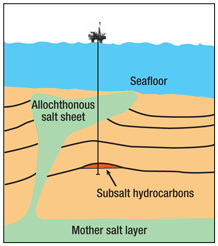 |
|
Fig. 1. An allochthonous salt sheet propagates up a slender salt stalk from the mother salt layer.
|
|
With the development of subsalt imaging came deep drilling, which led to discovery after discovery. By 2007, more than 27 penetrations had been drilled into the Wilcox Formation with a 63% success rate. More than 12 billion bbl of oil-in-place has been booked, and there remains an upside potential estimated upward of 15 billion bbl, a large percentage of which will come from subsalt reservoirs. Drilling targets range from 10,000 to 30,000 ft (3,049 to 9,146 m).
GUIDELINES FOR BEST PRACTICES
Augmented by greatly improved seismic imaging, explorationists were encouraged to go for the gold. It became the job of the drillers to get them there. As expected, there were challenges. Salt behaves badly when drilled. It can leech into the mud system, leaving large washouts in the borehole. Conversely, it can creep through plastic deformation, closing off the borehole and actually impinging on drill pipe or casing. Salt contains random inclusions of other minerals that can cause drilling breaks, and cuttings transport can be problematic, resulting in stuck BHAs.
A salt canopy can prevent subterranean heat flow from rising naturally, creating a hot-spot surprise when the bit drills out of the salt; oftentimes an unconsolidated breccia zone is found immediately beneath salt overhangs—an artifact of the upward thrust of the salt column. Formation water, trapped in unconsolidated sediments beneath salt layers, can become geopressured as overlying sediments subside and consolidate. These geopressured zones can cause tremendous influxes of highly charged water from deep aquifers, which can result in a blowout or loss of the well.
Such a daunting array of challenges facing drillers begged an investigation to analyze salt penetration experiences and develop best practices for drilling the Gulf of Mexico’s salt sections. It should be noted that because these practices are experience-based, they may not be appropriate for export to salt deposits elsewhere in the world. Gulf of Mexico salt is characterized as “cold” salt, meaning it has relatively low temperature and low mobility and is fairly pure. Halite comprises 97% of the GOM salt, with some anhydrite impurities. Typical salt density is 2.10 g/cc, and it has a high coefficient of friction. The rotational friction factor can be as high as 0.45, compared with normal sediments which have factors ranging from 0.18 to 0.30.
Analysis of drilling records from GOM salt penetrations revealed the following non-exclusive list of problems that must be considered when developing best practices.
Salt modeling. All drilling benefits from pre-spud geomechanical modeling, and is also enhanced by real-time updates from LWD or MWD dynamic inputs. Salt is no exception. However, seismic is inhibited in salt as there is little velocity change through the section to create reflections. Salt also contains surprises in the form of inclusions that contain unpredictable stresses and often masquerade as the base of salt, leading drillers to set casing prematurely. Frequently, sulfur inclusions are encountered. In addition to mineralogical inclusions, salt properties can vary, depending on temperature, pressure and tectonic stresses.
Creep. Owing to its plastic nature, salt can creep. Immature salt creep can actually shear or collapse casing. Accordingly, concentric reamers are typically included in most BHA designs to open the hole.
Tortuosity. Because of its high friction factor, salt should be penetrated with minimal tortuosity, especially in the vertical section. High-lubricity mud systems should be considered. Typically, subsalt reservoirs must be drilled with deviated wellbores, and any unnecessary uphole friction detracts from available energy to apply weight-on-bit while drilling the pay section.
Leeching. Water-based mud systems tend to leech salt, causing unstable boreholes and washouts. Also, salt-contaminated mud adversely affects the responses of resistivity logging devices.
Directional control. Directional changes in the salt body are traditionally avoided due to the general inability to geosteer and the effect directional variation has on torque and drag. Beneath the salt, it is not unusual to encounter steeply dipping beds that contribute to “bit walk.”
Shock and vibration. Due to the plastic nature of salt and its unexpected inclusions, destructive vibrations can be encountered. The most damaging are stick-slip, lateral and torsional vibrations. Vibration can be exacerbated by the use of necessary concentric reamers used to open the wellbore to combat creep.
Bit selection. Although conventional rock bits have proven effective in salt drilling, the use of aggressive PDC bits has resulted in generally higher penetration rates, helping to get through the salt as quickly as possible.
Low fracture gradient. Mobilized salt can cause abnormally low fracture pressure gradients immediately above and beneath the salt body.
Sub-optimal motors. Equipment problems plagued early attempts at salt penetration. Although most deepwater salt sections are drilled vertically, a directional assembly is required to maintain verticality. Without this precaution, the borehole drifts off line, creating unacceptable torque and drag issues. Early attempts at deepwater salt drilling involved a mud motor with a rotary pendulum or a rotary hold assembly.
However, neither of these systems ensured that the resulting borehole would be vertical, and much time was wasted reducing weight-on-bit to help maintain verticality or making multiple passes back-reaming. Steerable motor drilling was attempted, but it suffered the same problems, particularly while in sliding mode.
Additional problems typically encountered with motor drilling included twist-offs—due to aggressive bent housing settings necessary to minimize the lengths of slide sections—and difficult toolface control. Slower-speed/high-torque motors seemed to work best but suffered low penetration rates. Bit selection options were limited because of the necessity to maintain toolface control while sliding. And the ability to use concentric reamers was impaired; they developed high torque if placed below the motor and yielded poor dogleg and hole gauge capability if placed above the motor. In addition, the motor cannot slide if the reamer is above it.
ELIMINATING ROTARY STEERABLE SHAKE
The first use of Schlumberger’s Rotary Steerable System (RSS) for Gulf of Mexico salt penetration was in 2000. Since that time, more than 186 runs have been made totaling almost half a million feet of salt section drilling. Results have been encouraging. Firstly, the problematic slide-drilling mode has been eliminated. With RSS, it is easier to maintain verticality without back-reaming and while maintaining maximum weight-on-bit. Better hole quality results, as do better hole cleaning and reductions in drag and sticking incidents.
Initially, RSS reliability was a disadvantage, but this has since been resolved through technology improvements. RSS reliability is now equivalent to that of a downhole motor, as seen by steady increases in run length and ROP, Fig. 2. Increased cost was first feared to be an issue, but that was more than offset by improved drilling efficiency. Average Rate Of Penetration (ROP) for RSS on 186 runs was 61 ft/hr (18.6 m/hr). Comparable runs with a motor averaged 20% to 40% lower ROP, Fig. 3. When RSS runs were combined with concentric reamers, ROP actually increased for some bit size combinations, Fig. 4. Since 2004, when significant technological reamer improvements were implemented, footage drilled with RSS reamer combinations has increased dramatically.
|
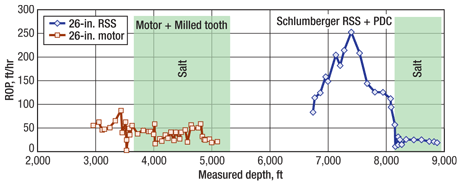
|
|
Fig. 2. Comparison of salt drilling efficiency between a traditional mud motor assembly and a rotary steerable system (salt sections are shown in green).
|
|
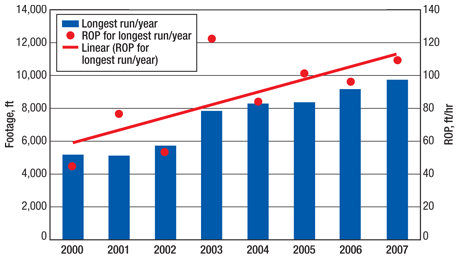 |
|
Fig. 3. RSS reliability and ROP have increased steadily in Gulf of Mexico salt drilling.
|
|
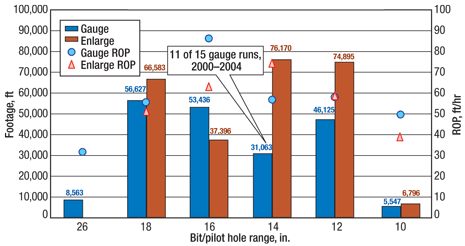 |
|
Fig. 4. Footage and average ROP for different hole sizes with (red) and without (blue) a concentric reamer.
|
|
Vibration benefited from RSS technology as well. When concentric reamers were deployed between the RSS assembly and the MWD/LWD collars, 55% of runs experienced severe shock and vibration, but when the reamers were moved above the MWD/LWD tools, shock and vibration runs dropped to 20%. In addition, log quality was positively affected by having the measurements taken before the hole was reamed. With logs run in a smaller diameter borehole, the hole signal is greatly reduced and the relative formation signal quality is enhanced. Simply placing the concentric reamers above the MWD/LWD tools reduced the number of BHA failures experienced, Fig. 5. In 2004, 24.3% of runs experienced failures. By 2007, the number was reduced to less than 8%.
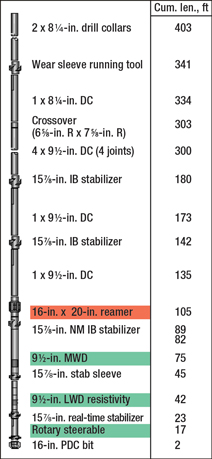 |
|
Fig. 5. An optimum BHA design with a concentric reamer placed above MWD/LWD tools. Logs are thereby run with smaller annulus and give better formation responses.
|
|
CONCLUSIONS
RSS technology has revolutionized salt drilling. By taking a systematic approach and by treating the entire drilling system as an integrated assembly, thick, deep salt sections can be drilled successfully, quickly and with acceptable risk. Teamwork and knowledge management play key roles in achieving these goals. 
ACKNOWLEDGMENT
This article is adapted from SPE 118870, “The Evolution of rotary steerable practices to drill faster, safer and cheaper deepwater salt sections in the Gulf of Mexico,” presented at the 2009 SPE/IADC Drilling Conference held in Amsterdam, the Netherlands, March 17–19, 2009.
|
THE AUTHORS
|
 |
Marco Aburto is based in Houston and has been a Schlumberger Drilling Engineer for the northern Gulf Coast since 2006. He began his career in 2001 as a Drilling & Measurements Field Engineer in different US locations, including California, Oklahoma, Wyoming and Alaska. In 2004, he joined Baker Hughes and moved to Mexico as a Drill Bit Applications Engineer. In 2006, he moved to Houston to gain deepwater drilling experience in the Gulf of Mexico. Mr. Aburto earned a BS degree in mechanical engineering from Universidad de las Americas in Puebla, Mexico.
|
|
 |
Robert Clyde is the Drilling Engineering Manager for North and South America, based in Houston, for the Drilling & Measurements division of Schlumberger. He joined the company in 1990 and has held several positions with it in the Gulf of Mexico, the North Sea and Venezuela. He holds a BS degree in engineering with honors from the University of Strathclyde, Glasgow.
|
|









